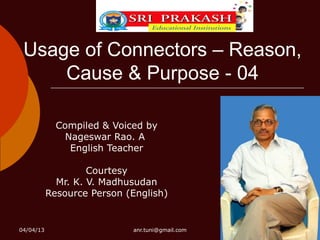
Connectors reason, cause & purpose - 04
- 1. Usage of Connectors – Reason, Cause & Purpose - 04 Compiled & Voiced by Nageswar Rao. A English Teacher Courtesy Mr. K. V. Madhusudan Resource Person (English) 04/04/13 anr.tuni@gmail.com
- 2. In this lesson we learn the usage of CONNECTORS OF REASON, CAUSE & PURPOSE. We use the following connectors to introduce the above. In order that; So that We use “In order that; So that” to introduce “reason, cause or purpose”. But the structure that we follow for the usage of the above connectors is completely different from our previous connectors – reason, cause or purpose. Connector + subject + modal + base form of the verb 04/04/13 anr.tuni@gmail.com
- 3. Let us study the following pair of sentences. He can buy a car. He needs to save money. In order that he can buy a car he needs to save money. So that he can buy a car he needs to save money. In order that you can pass the examination you need to study. So that you can pass the examination you need to study. In order that I can solve the problem I need not to worry. So that I can solve the problem I need not to worry. 04/04/13 anr.tuni@gmail.com
- 4. We should not get confused “In order that” with “In order to or In order for” In order that needs a subject whereas “In order to” needs a base form of the verb and “In order for” needs a pronoun. In order to buy a car he needs to save money. In order for him to buy a car he needs to save money. Hope the doubt is clarified. LET LEARNING CONTINUES. 04/04/13 anr.tuni@gmail.com
- 5. Visit us at “ayalasomayajula nageswar rao” For More videos on Functional & Usage Grammar. Subscribe to our channel on You Tube 04/04/13 anr.tuni@gmail.com
- 6. Visit us at “ayalasomayajula nageswar rao” For More videos on Functional & Usage Grammar. Subscribe to our channel on You Tube 04/04/13 anr.tuni@gmail.com
